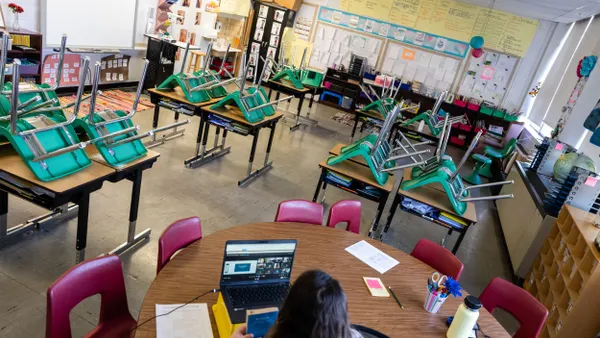Dive Brief:
- To successfully address the nationwide teacher shortage, the U.S. Department of Education needs to clearly communicate time frames, milestones and performance measures on this issue, the U.S. Government Accountability Office reported Thursday. While the Education Department has established five strategies to support teacher development and address recruiting and retention concerns, more is needed, GAO said.
- Staffing issues are particularly acute in Western states, urban and rural districts, high-poverty communities and schools that predominantly teach students of color, the GAO report found. Especially tough to fill are spots in science, foreign languages and special education, the agency said.
- To help states and districts address specific recruitment and retention concerns, GAO suggested that U.S. Education Secretary Miguel Cardona direct the Federal Student Aid agency, the Office of Elementary and Secondary Education and the Office of Special Education and Rehabilitative Services to collect and share resources.
Dive Insight:
The report echoes concerns over the teacher shortage from education leaders who have repeatedly noted a lack of concrete, consistent data to track the recruitment and retention of teachers — whether at the state or federal level.
But efforts are slowly being made to collect this data in some areas. On Sept. 30, California Gov. Gavin Newsom signed a state law encouraging districts to administer an exit survey within 15 days of a teacher’s resignation beginning in the 2023-24 school year. The state legislature will then use the data, which is to be publicly available on an annual basis, to consider statewide investments for teacher retention and recruitment efforts.
Besides national surveys looking to gauge the scope of teacher shortages conducted by the Education Department’s National Center for Education Statistics, there really isn’t a lot of other nationwide — let alone state — data available on the matter. But there are some states and research firms looking to change that, as seen by efforts in Missouri and emerging research by the Annenberg Institute at Brown University and others.
In the summer, the Education Department shared its five strategies “to supporting and elevating the teaching profession.” They are:
- Investing in a diverse teacher pipeline.
- Supporting teachers in earning an initial or additional certification for high-demand areas.
- Helping teachers pay off student loans.
- Providing teachers and students with resources needed to succeed.
- Creating opportunities for teacher advancement and leadership.
GAO said data that measures performance and the milestones for these efforts are needed to better position the department to help districts and state leaders know if solutions to address the teacher shortage are working.
The NCES surveys continue to show district leaders are concerned about staffing shortages, as a September survey found 53% of public school leaders reported feeling their schools were understaffed heading into the 2022-23 school year.
The latest GAO report also found, in its analysis of research published from 2011 to 2021, that the same issues repeatedly appeared in recruitment and retention challenges: a negative perception of the teaching profession and lack of support for current teachers.
Additionally, GAO said common barriers to recruitment include the high cost of becoming a teacher and differing state licensure requirements. At the same time, retention challenges remained in both school workplace culture and low teacher compensation.







 Dive Awards
Dive Awards







